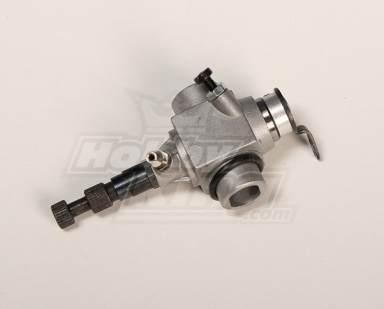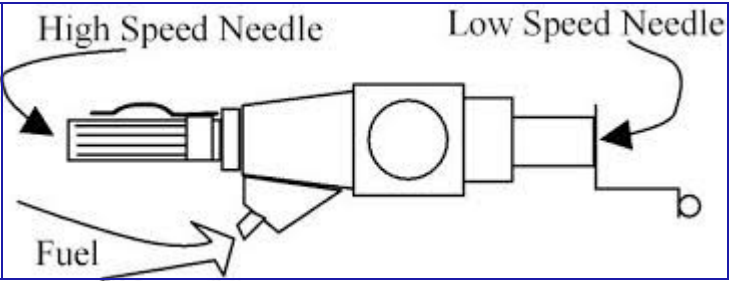Too often, we see newcomers to our hobby ask online how many turns do I set my needle valves, or I messed up the factory setting, how do I setup my low end needle so I can start my engine? The manual does not give me the starting points to setup the settings.Here are some great tips to make you an expert engine tuner.
 How to setup the needles so you can get your engine started:
How to setup the needles so you can get your engine started:
Start by opening the high end needle about 4 turns from fully closed. This is just a starting point to ensure the high end needle valve isn't restricting fuel to the carb so you can adjust the low end needle setting.
The low end is easily set to a good starting point with the following procedure:
Close low end needle valve completely. Install a clean piece of fuel tubing into carb fitting; make sure it is long enough for you to blow into it with your mouth.
Open carb to 1/5 open from closed position
Blow into fuel tubing while slowly opening up the low end needle valve. Stop turning low needle valve when you first feel air blowing into carb from your mouth or hear the sound of air blowing into carb. The flow should be restrictive and very small. We only want a small amount of fuel to flow (air to flow) at 1/5 throttle opening. This low end needle setting will get your engine running and may require further adjustment. This is just a ball park setting.
Now close high end needle valve and open carb to full throttle. Blow in fuel tubing and simultaneously open high end needle until you have FREE FLOW of air into carb. You should not experience as much resistance to air pressure as you did on the low end. Your needle valve should be open between 2-3 turns (it all depends on the carb folks).
This procedure guarantees you don't have a blocked carb or closed needle settings for low and high. This will get you in the ballpark which then will require you to fine tune your low end and high end for best performance--highly recommend the pinch test .
Pinch test procedure:
Prime the engine by opening up throttle to full and blocking the carb with your finger, watch the fuel line to see fuel displacing the air in the line.
Remember the following rules about needles:
- Low end needle affects the mixture below 1/2 throttle for most engines. Use it to adjust the idle and the transition from idle to full throttle.
- High end needle affects mixture above 1/2 throttle. Adjust it so engine is running 300-400 rpm shy of max lean rpm at wide open throttle. Reduce throttle from full to about 1/5 throttle opening.
Apply glow ignitor and rotate engine (hopefully w/ starter) until engine starts. When engine starts, move throttle to 1/2 and then remove glow driver. If engine won't start, try more throttle until it does. If engine will only start above 1/2 throttle, it means your initial low end needle setting was too lean. Richen it about an 1/8th of a turn until the engine starts at a low throttle (1/5 throttle) setting.
 If engine will not advance to 1/2 throttle w/ glow driver is on then leave at 1/5 throttle with glow driver until engine is warmed upabout 2 minutes should do the trick.\Advance throttle again to 1/2 throttle slowly. If en- gine dies then your low end needle is probably too lean. Richen by 1/10 increments.
If engine will not advance to 1/2 throttle w/ glow driver is on then leave at 1/5 throttle with glow driver until engine is warmed upabout 2 minutes should do the trick.\Advance throttle again to 1/2 throttle slowly. If en- gine dies then your low end needle is probably too lean. Richen by 1/10 increments.
Once you can get your engine running at 1/2 throttle then its time to remove the glow driver. With glow driver removed, advance throttle to full throttle. Chances are your engine will be too rich and may even quit. If so, briefly pinch and release fuel line as you advance to full throttle to verify the mixture is too rich. If it is too rich, then in small increments lean it out until it will run at full throttle without quitting. This does not mean the high end mixture needle is set. This is just a starting point to ensure your engine is running at wide open throttle (WOT) so you can make the proper adjustments.
With engine running at full throttle, slowly and carefully lean the high end needle valve until the engine is spinning at its max rpm. Verify this by briefly pinching and releasing the fuel line to the carb. If the pinch test causes the engine to speed up and back down, then you have correctly set your high end needle setting. If engine doesn't speed up much or dies then you are still to lean and need to riche the mixture slightly until it passes the pinch test. You are almost there.
With high end needle setting set about 300 rpm rich of max lean rpm, recheck idle and transition. Let engine idle for 30-60 seconds and then snap throttle to WOT. If engine hesitates in the transition, fine tune mixture so that the transition is snappy and idle is reliable. I personally like a lean idle mixture so I can idle for long periods without fuel pooling up in the crankcase which causes stumbles when transitioning to full throttle. You can also use the pinch test when the engine is idling. Pinch and hold fuel line with engine at a fast idle. Engine should speed up and die about 4 seconds. If it takes longer, your low end needle is too rich, if it takes less time or if your engine dies instantly, you are to lean and need to richen your low end needle.
Once low end needle is set, you will probably never have to adjust it again. However, your high end needle should be checked before every flight by doing the pinch test at WOT to verify the mixture is slightly rich. This 5 second test and adjustment, if necessary, will guarantee you a reliable engine that will last a long time. Our carbs do not adjust for changes in temperature, humidity, barometric pressure, etc... and a small change of 5 degrees in temp can cause a properly tuned carb to be out of tune and possibly too lean (or too rich depending on whether it gets hot or cold outside).

